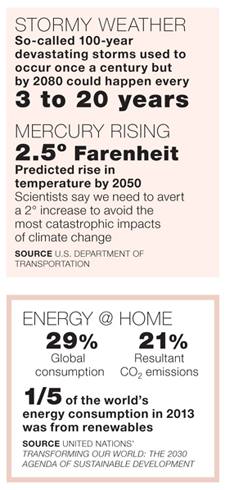The Future of the Planet | Designing the Future
As society faces what many now call the Anthropocene age, the impacts of climate change and humankind’s role in it will influence, literally, everything
 CROWDSOURCING CLIMATE DATA
CROWDSOURCING CLIMATE DATA The ship’s log of whaling vessels—especially those that journeyed to the arctic—can contain valuable data on what the weather was like more than a century ago and the state of arctic ice. For a long time, they were not being mined by climate scientists seeking to understand modern-day climate change, but that’s changing. Driven by researchers at the National Oceanic and Atmospheric Administration (NOAA), the Old Weather Whaling project has digitized more than 200 logs from sources including the New Bedford Whaling Museum (NBWM), the Providence Public Library, the National Archives, and other institutions. In concert with the Boston Public Library and the Internet Archive, the records were digitized and brought online. But that alone was not enough to make them truly useful to scientists.
“Getting primary sources out there is great, but there’s still some interpretation needed,” says NBWM librarian Mark Procknik. “The information can be technical, and the spelling is often bad.”
Enter citizen scientists, enabled by Zooniverse, an online platform built to allow them to participate in research. Legions of volunteers can help transcribe the handwritten logs. Procknik and his colleagues also assembled a helpful guide on how to read the logbooks to assist this crowdsourced transcription.—Ian Chant
 The Next Species: The Future of Evolution in the Aftermath of Man by Michael Tennesen (S. & S., Mar. 2016)
The Next Species: The Future of Evolution in the Aftermath of Man by Michael Tennesen (S. & S., Mar. 2016)
Earth in Human Hands: The Rise of Terra Sapiens and Hope for Our Planet by David Grinspoon (Grand Central, Dec. 2016)
Half-Earth: Our Planet’s Fight for Life by Edward O. Wilson (Liveright: Norton, Mar. 2016)
Rise of Regenerative Design
 Green is not good enough. Now, a new set of standards—the Living Building Challenge (LBC)—looks for buildings actively to improve the world around them. LJ speaks to Samuel Wright, manager, LBC, about how new built spaces, including libraries, are embracing the challenge.
Green is not good enough. Now, a new set of standards—the Living Building Challenge (LBC)—looks for buildings actively to improve the world around them. LJ speaks to Samuel Wright, manager, LBC, about how new built spaces, including libraries, are embracing the challenge.
The Living Building Challenge is a certification standard and a philosophy centered on regenerative design. Rather than just having no negative impact, these buildings seek to confer net benefits on a site. The program holds buildings to standards of performance, which is why spaces [must] be open and operating for at least 12 months prior to certification.
 What are some techniques used?
What are some techniques used? The way a building meets those standards is up to the design team to accomplish in a local context. A living building in Anchorage, AK, is a very different space from one in Adelaide, Australia. A prep academy in a rather arid part of Hawaii is harvesting condensate water into a cistern to satisfy its entire water demand. A lot of the solutions that we see in living buildings aren’t new, but they are being incorporated into modern buildings in a way that increases efficiency without sacrificing comfort.
One of our Net Zero Energy certified buildings is a library in Chrisney, IN, which is a very small, rural community. The people who initially proposed it realized that one key to success would be to limit or even negate operating costs—that way, the initial investment could be offset by savings in the operations budget over time. For that space, achieving Net Zero Energy certification wasn’t a challenge, it was a solution.
Education is part of any library’s mission, and living buildings can serve as epitomes of the built environment. They show what a really good building can look like and how it can function. And since they are public spaces and community hubs that invite people to learn, they make great places to display that example.—IC
RELATED
ALREADY A SUBSCRIBER? LOG IN
We are currently offering this content for free. Sign up now to activate your personal profile, where you can save articles for future viewing









Add Comment :-
Comment Policy:
Comment should not be empty !!!